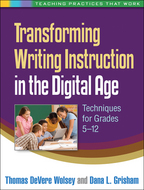Transforming Writing Instruction in the Digital Age
Techniques for Grades 5-12
Thomas DeVere Wolsey and Dana L. Grisham
Foreword by Bridget Dalton
This title is part of the Teaching Practices That Work Series, edited by Diane Lapp and Douglas Fisher.
“Rich with authentic and inspiring examples, this book clearly addresses the 'whats,' 'whys,' and 'how-tos' of integrating technology into writing instruction. It is like an innovative colleague sitting by my side during those stages of curriculum planning when I'm seeking creative support and in need of my own transformative learning experience.”
—Melissa Provost, MSEd, language arts teacher, Portsmouth (New Hampshire) Middle School
“The authors offer an impressive range of practical solutions for promoting skilled academic writing and transformative thinking. Each chapter pairs sound pedagogical practices with concrete examples of how to differentiate and digitize writing instruction across multiple modes and purposes. The authors' keen insights will inspire even the most wary educators to hop on board and join their digital writing adventure.”
—Julie Coiro, PhD, School of Education, University of Rhode Island
“Students will benefit and progress will be made when educators begin to focus on the technology tools that nearly all adolescents already know how to use. Those of us in the classroom who adopt technology readily (and those who are more hesitant) will benefit from a book such as this to get ideas to fine-tune our daily lessons. All secondary teachers, not just English teachers, will find accessible ideas for improving writing instruction in the digital classroom.”
—Paula Dreyfuss, MSEd, teacher, Vista Unified School District, California
“Filled with ideas and instructional activities that cut across all content areas, this stimulating book showcases ways to use technology to help students create, communicate, collaborate, and learn. Through scenarios set in real classrooms, the authors bring to life both the big picture and the day-to-day realities of how to prepare students for new forms of writing and communication in the 21st century. Teachers, literacy coaches, curriculum specialists, and teacher educators will discover a wealth of new learning opportunities that will transform the way they teach.”
—Jill Castek, PhD, Department of Teaching, Learning, and Sociocultural Studies, University of Arizona
“This powerful book fills a huge gap. Teachers recognize the need to respond to students in 21st-century ways, but many just do not know how. Wolsey and Grisham provide classroom-ready ideas for using digital tools to teach writing, complete with solid rationales. The book is organized in such a way that teachers can read it from beginning to end, as I did, or identify specific areas of interest and find ways to improve teaching. I look forward to sharing this book with my students and colleagues.”
—Susan Lenski, EdD, Department of Curriculum and Instruction, Portland State University
Table of Contents
IntroductionHashtags by Technique
I. Getting Started with Tools and Teaching
Technique 1. Resources: Anytime, Anywhere
Technique 2. Management: Computers in the Classroom
Technique 3. Management: The Hardware
Technique 4. Direct Instruction
Technique 5. A Word about Differentiation
II. Writing and Thinking
Technique 6. Embracing Writing: Knowledge-Transforming Writing
Technique 7. Why Writing Is a Process, and How Technology Can Help
Technique 8. Working with Sources: Keeping Track of Learning, and Leaving a Path for Others to Follow
Technique 9. Working with Sources: Using Style Guides
III. Writing to Understand: It’s All about the Discipline
Technique 10. Discussion and Writing
Technique 11. Writing Short Pieces
Technique 12. Short Writing: Electronic Journals
Technique 13. Blogs and Classroom Websites for Writing
Technique 14. Online Literature Discussion (Threaded Discussion)
Technique 15. Vocabulary and Writing
Technique 16. Collaborative Writing
Technique 17. Are Those Kids Texting Again?
IV. Inquiry and Long Thinking Meet the Disciplines
Technique 18. FAQs about Writing in the Disciplines
Technique 19. It’s All the Same, or Maybe Not?
Technique 20. What Was That Essential Question Again?
Technique 21. Learning Because I’m Writing: Logs and Journals
Technique 22. Writing Is (Hard) Cognitive Work: Bloom’s Taxonomy Matters
Technique 23. Internet Inquiry
Technique 24. Prompts
Technique 25. Prewriting: Composing before Writing with Pen or Keyboard
Technique 26. Prewriting with Graphic Organizers
Technique 27. Feedback, Assessment, and Technology
V. What about Literature and English Language Arts?
Technique 28. Short Writing: Summaries in Response to Reading
Technique 29. The Zen of Writing about Literature
Technique 30. Persuasion: In This Essay, I’m Going to Convince You…
Technique 31. Prompts for Writing: Language Arts
VI. Composing with Multimedia
Technique 32. Visualize It!
Technique 33. Podcasting: It’s Ear-resistible
VII. Wrapping It Up
Technique 34. Advocacy for Technology and New Literacies
Technique 35. High-Stakes Writing Assessments
Technique 36. Automated Tools
Technique 37. Publication
Appendix: Common Core Content Standards for Writing, Grades 6–12
Glossary
About the Authors
Thomas DeVere Wolsey, EdD, teaches graduate courses in research and literacy and leads professional development for teachers throughout the United States, including on the Hopi Reservation in Arizona, as well as in Egypt, Guatemala, Mexico, China, and elsewhere. He is the author or coauthor of numerous books for teachers and teacher educators, most recently on the topic of teaching refugees and displaced students. Dr. Wolsey has developed training materials for the California Department of Education, TextProject, San Diego State University, and other institutions and programs. His research and writing explore the intersections of literacy and technology, middle grades and secondary literacy practices, teacher preparation, and green school design.Dana L. Grisham, PhD, is Professor (retired) at the California State University and is noted for her research on teaching, particularly concerning the intersection of literacy and technology. She has over 80 publications, including books, book chapters, and articles in national and international journals. Dr. Grisham is a past editor of Reading and Writing Quarterly, Reading Online, and The California Reader.
